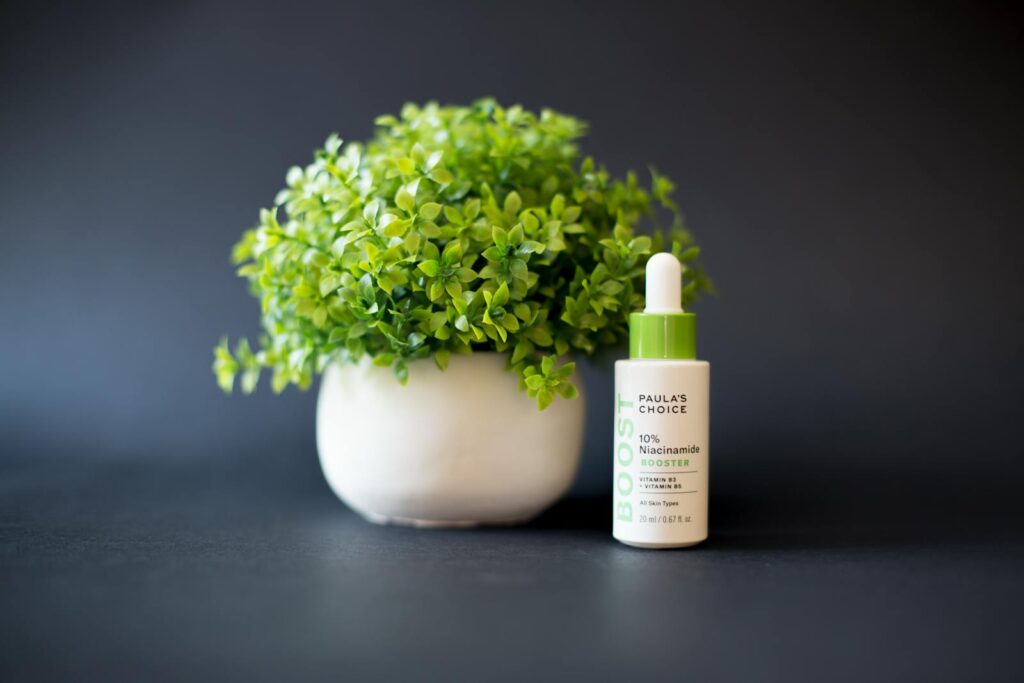Wondering if you can mix niacinamide and glycolic acid in your skincare routine? You’re not alone! Many people want to know if these popular ingredients play well together.
You can use niacinamide and glycolic acid together, but it’s important to do so carefully. Both are active ingredients that can benefit your skin in different ways.
Niacinamide helps with things like reducing redness and improving skin texture. Glycolic acid is great for exfoliating and treating acne.
If you have sensitive skin, you might want to use these ingredients at different times of day. Try niacinamide in the morning and glycolic acid at night. This can help avoid irritation.
Remember to start slow and see how your skin reacts. Your skin will thank you for being gentle!
Understanding Niacinamide and Glycolic Acid
Niacinamide and glycolic acid are popular skincare ingredients with unique properties. They offer different benefits for your skin health and appearance.
Properties of Niacinamide
Niacinamide, also known as vitamin B3, is a water-soluble vitamin. It has many great effects on your skin:
- Helps reduce inflammation
- Improves skin barrier function
- Regulates oil production
- Fades dark spots
Niacinamide is gentle and suits most skin types. You can use it daily without irritation. It works well in both morning and night skincare routines.
Benefits of Glycolic Acid
Glycolic acid is an alpha-hydroxy acid (AHA). It’s known for its exfoliating powers. Here’s what it can do for your skin:
- Removes dead skin cells
- Improves skin texture
- Boosts collagen production
- Helps with acne and fine lines
Glycolic acid is stronger than niacinamide. Start using it 1-2 times a week. Increase slowly as your skin adjusts.
Always use sunscreen when using glycolic acid, as it can make your skin more sensitive to the sun.
Combining Niacinamide and Glycolic Acid
Niacinamide and glycolic acid can work well together to improve your skin. These ingredients offer benefits for acne, hyperpigmentation, and overall skin health when used properly.
Synergy for Acne and Hyperpigmentation
Niacinamide and glycolic acid team up to fight acne and dark spots. Niacinamide helps control oil production and reduces inflammation. This can lead to fewer breakouts.
Glycolic acid removes dead skin cells, unclogs pores, and fades dark marks.
Together, they can:
- Improve skin tone
- Reduce acne scars
- Minimize fine lines and wrinkles
- Boost collagen production
Your skin might look brighter and feel smoother when you use both ingredients. They also work to protect your skin from sun damage and environmental stress.
Precautions and Ideal Usage
While niacinamide and glycolic acid can be great for your skin, you need to use them carefully. Glycolic acid can sometimes cause irritation, especially if you have sensitive skin.
Here are some tips for safe use:
- Start with low concentrations of each ingredient.
- Use them at different times of day (glycolic acid at night, niacinamide in the morning).
- Always apply sunscreen during the day, as glycolic acid can make your skin more sun-sensitive.
If you have very sensitive skin, talk to a dermatologist before combining these ingredients. They can help you create a skincare plan that works for you without causing irritation.
Incorporating into Your Skincare Regimen
Adding niacinamide and glycolic acid to your routine can boost your skin’s health. Here’s how to use them together safely and effectively.
Step-by-Step Application
Start with a gentle cleanser to remove dirt and oil. Apply glycolic acid first, as it works best on clean skin.
Wait 10-15 minutes to let it absorb. Next, apply your niacinamide product. This order helps each ingredient work its magic without interference.
Follow up with a moisturizer to keep your skin hydrated. This step is extra important when using acids, which can be drying.
Always finish with sunscreen during the day, as glycolic acid can make your skin more sun-sensitive.
At night, you can skip the SPF but keep the other steps. If your skin feels irritated, use these products on alternate days or reduce how often you use them.
Recommended Products
Look for serums or toners with 5-10% niacinamide. These work well for most skin types, including oily and acne-prone skin.
For glycolic acid, start with lower concentrations (5-7%) and work your way up if needed.
Some great options include:
- The Ordinary Niacinamide 10% + Zinc 1%
- Paula’s Choice 10% Niacinamide Booster
- The Inkey List Glycolic Acid Toner
- Pixi Glow Tonic (5% Glycolic Acid)
Remember to patch test new products before adding them to your routine. This helps avoid any unwanted reactions, especially if you have sensitive skin.
Additional Considerations
Using niacinamide and glycolic acid together can be great for your skin. But there are some extra things to keep in mind. Let’s look at how to address specific skin issues and when you might want to talk to a doctor.
Addressing Specific Skin Concerns
Niacinamide and glycolic acid can help with many skin problems. For dark spots and uneven skin tone, this combo works well.
Glycolic acid removes dead skin cells, while niacinamide helps fade pigmentation.
If you have large pores, both ingredients can help. Glycolic acid cleans out pores, and niacinamide can make them look smaller.
For aging skin, glycolic acid boosts collagen, and niacinamide improves skin texture. This can help with fine lines and wrinkles.
If you have acne scars, glycolic acid can smooth skin texture. Niacinamide may help reduce redness and inflammation.
When to Consult a Dermatologist
Sometimes, it’s best to talk to a skin doctor before using these products. If you have sensitive skin or rosacea, ask a dermatologist first. These ingredients might be too strong for you.
For serious skin issues like melasma, a doctor can give you the best advice. They might suggest different strengths or ways to use these products.
If you’re pregnant or breastfeeding, check with your doctor. Some skincare ingredients might not be safe during this time.
A dermatologist can also help if you’re not seeing results after a few weeks. They might adjust your routine or suggest other treatments.
Frequently Asked Questions
Combining niacinamide and glycolic acid in your skincare routine can be tricky. Here are some common questions to help you use these ingredients together safely and effectively.
What’s the recommended order for applying glycolic acid and niacinamide?
Use glycolic acid first on clean, dry skin. Wait 10-15 minutes before applying niacinamide. This lets the glycolic acid work at its ideal pH level.
Glycolic acid goes on early in your routine. Niacinamide can be used later with other serums or moisturizers.
Are there any conflicts between niacinamide and glycolic acid when used in a skincare routine?
Niacinamide and glycolic acid work well together. They don’t cancel each other out or cause negative reactions.
Glycolic acid exfoliates and brightens skin. Niacinamide helps with oil control and pore size. Using both gives you more benefits.
Can I safely include hyaluronic acid in my routine along with niacinamide and glycolic acid?
Yes, you can use hyaluronic acid with niacinamide and glycolic acid. Hyaluronic acid adds moisture without interfering with the other ingredients.
Apply hyaluronic acid after glycolic acid but before niacinamide. This helps lock in hydration and prevent dryness from the glycolic acid.
How should I incorporate vitamin C when using niacinamide and glycolic acid?
Use vitamin C in the morning and glycolic acid at night. This prevents possible irritation from mixing acidic ingredients.
You can use niacinamide with vitamin C or glycolic acid. Just apply vitamin C first, wait a few minutes, then add niacinamide.
Which should I use first if I want to use both salicylic acid and glycolic acid with niacinamide?
Start with salicylic acid, then glycolic acid, and finish with niacinamide. Use salicylic acid in the morning and glycolic acid at night to avoid irritation.
Wait 10-15 minutes between each acid and before applying niacinamide. This lets each ingredient work at its best pH level.
What are the benefits of combining glycolic acid with other skincare ingredients?
Glycolic acid works well with many ingredients. It boosts the effects of antioxidants like vitamin C and E.
Glycolic acid also helps other products absorb better. It removes dead skin cells, letting serums and moisturizers penetrate deeper.



